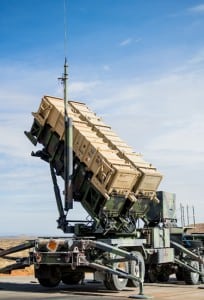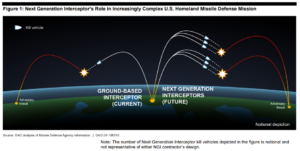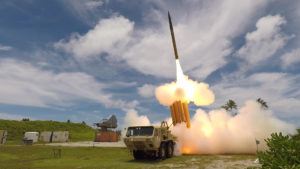Ground-based Interceptor (GBI)
-
 Missile Defense
Missile DefenseMDA Investigating Low Cost Missile Defense Interceptor Under $1 Million
The Missile Defense Agency last week solicited white papers toward ultimately quickly demonstrating a Low-Cost Interceptor (LCI) under $1 million each that could help supplement defense against ballistic and hypersonic […]
Tagged in: -
 Missile Defense
Missile DefenseMDA’s Next-Gen Interceptor And First Hypersonic Defense Systems Already Running Late From Early Downselects
The director of the Missie Defense Agency (MDA) last week confirmed both the next homeland ballistic missile defense interceptor and first dedicated hypersonic missile defense interceptor are both running late […]
Tagged in: -
 Missile Defense
Missile DefenseFinal Defense Authorization Bill Orders East Coast Missile Defense Site
The House and Senate conference version of the fiscal year 2025 defense authorization bill includes a House provision requiring DoD establish a third missile defense interceptor site on the East […]
-
 Missile Defense
Missile DefenseVoyager Space To Provide Lockheed Martin NGI Upper Stage Propulsion
Voyager Space said Monday that Lockheed Martin [LMT] chose it to help deliver a solid-propulsion subsystem to the company’s Next Generation Interceptor (NGI) for the Missile Defense Agency (MDA). Voyager […]
Tagged in: -
 Missile Defense
Missile DefenseGAO Says NGI Plan With Overlapping Design And Production Adds Risk, Schedule ‘Optimistic’
A new report from the Government Accountability Office (GAO) argued the Missile Defense Agency’s (MDA) Next Generation Interceptor (NGI) program faces challenges as it plans to overlap the design and […]
Tagged in: -
 Missile Defense
Missile DefenseU.S. and Japan Finalize Cooperative Development Agreement For Hypersonic Defense
The U.S. The Defense Department and Japan Ministry of Defense finalized an agreement to jointly develop and build a new hypersonic missile defense interceptor, with Japan to focus on propulsion […]
Tagged in: -
 Missile Defense
Missile DefenseLockheed Martin Wins Over Northrop For Next Generation Interceptor
The Missile Defense Agency (MDA) selected Lockheed Martin [LMT] Monday to continue development for the Next Generation Interceptor (NGI) over competitor Northrop Grumman [NOC]. In 2021, MDA chose teams led […]
Tagged in: -
 Missile Defense
Missile DefenseNGI Down-Select Coming This Month With Acquisition Strategy Change, MDA Director Says
The Missile Defense Agency’s (MDA) director last Friday told lawmakers the Next Generation Interceptor (NGI) is changing its acquisition strategy to have a down-select this month, rather than after the […]
Tagged in: -
 Missile Defense
Missile DefenseMDA’s 2025 Budget Requests $500 Million Less Than Previous Year
The Missile Defense Agency’s (MDA) fiscal year 2025 budget request is for $10.4 billion, $500 million less than the $10.9 billion requested in FY ‘24. For the first time in […]
Tagged in: -
 Missile Defense
Missile DefenseLockheed Martin Passes Another NGI Milestone On The Way To Critical Design Review
Lockheed Martin [LMT] said Wednesday it successfully passed another Missile Defense Agency (MDA) acquisition milestone in the Next Generation Interceptor competition as it barrels towards Critical Design Review (CDR) in […]
Tagged in:
